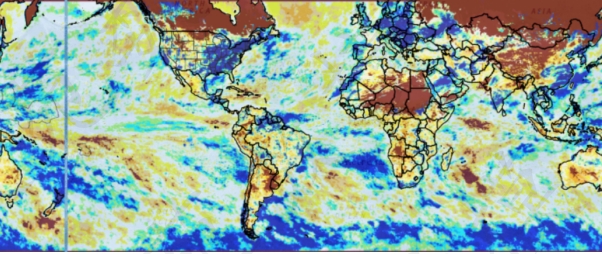Problem Chosen A
2023 MCM/ICM Summary Sheet
Team Control Number 2300336
Community Succession Simulation: Surviving Drought
Summary
The species richness of plant communities has a significant influence on their ability to withstanddrought. From an ecological niche perspective, we simulate plant community succession underdrought conditions and analyze the effects of various factors.
First, we develop the Plant Community Succession Model based on niche theory to simulate community succession under drought conditions. The model applies changes in niche width as the indicator to simulate community succession and utilizes competition matrix to describe in-teractions between species, including competition and facilitation. Then, the Niche Width Model is established, comprehensively considering the effects of reproduction, mortality, and uncer-tainties. Among them, reproduction depends on the degree of drought, niche width, interspecificrelationships, and environmental capacity, while mortality depends on the degree of drought andthe niche width. Uncertainties are measured with Gaussian white noise.
A niche width differential equation model is built based on the Beverton-Holt and the Lotka-Volterra equations. To account for various irregular weather cycles, we utilize random variables obeying normal distribution to simulate the extent and duration of drought. As a case study, we simulate the evolution of a three-species community and draw the conclusion that the total niche width of the community increases, suggesting long-term survival.
To investigate the influence of species number on community dynamics, we utilize the Plant Community Evolution Model to simulate communities containing one to four species separately. The results demonstrate that three species are necessary for the community to benefit. Additionally, as the number of species increases, the drought resistance improves and then stabilizes.
Based on the competition matrix, we set up three distinct communities and discuss their drought resistance through simulations. It can be concluded that facilitation-dominated relationships en-hance drought resistance and increase the community’s survival time. Moreover, we vary the frequency and intensity of drought and then conclude that species extinction is more likely to occur during severe droughts.
Pollution and habitat shrinkage affect plant communities’ niche width and competitive rela-tionships. Therefore, we adjust the niche width and competition matrix accordingly. The results indicate that pollution and habitat shrinkage may cause the extinction of certain species.
Finally, based on the impact of various factors, we recommend some measures to ensure the long-term viability of a plant community. Additionally, we also analyze the significance of protecting vulnerable communities for the overall health of ecosystems.
Keywords: Community succession; Drought resistance; Niche width; Population interactions;Beverton-Holt equation
Contents
1 Introduction 2
1.1 Background . . . . . . . . . . . . . . . . . . . . . . . . . . . . . . . . . . . . . . 2
1.2 Restatement of the Problem . . . . . . . . . . . . . . . . . . . . . . . . . . . . . . 2
1.3 Our Work . . . . . . . . . . . . . . . . . . . . . . . . . . . . . . . . . . . . . . . 2
2 Notations and Assumptions 4
2.1 Notations . . . . . . . . . . . . . . . . . . . . . . . . . . . . . . . . . . . . . . . 4
2.2 Assumptions . . . . . . . . . . . . . . . . . . . . . . . . . . . . . . . . . . . . . . 4
3 Plant Community Evolution Model 5
3.1 Model Overview . . . . . . . . . . . . . . . . . . . . . . . . . . . . . . . . . . . . 5
3.2 Initial Conditions and Niche Characteristics of Species . . . . . . . . . . . . . . . 6
3.3 Rules of Plant Community Evolution . . . . . . . . . . . . . . . . . . . . . . . . . 7
3.3.1 Effects of Species Reproduction on Niche Width . . . . . . . . . . . . . . 8
3.3.2 Effects of Species Mortality on Niche Width . . . . . . . . . . . . . . . . . 9
3.4 Irregular Weather Cycles . . . . . . . . . . . . . . . . . . . . . . . . . . . . . . . 10
3.5 Simulation of Plant Community Evolution . . . . . . . . . . . . . . . . . . . . . . 11
3.5.1 Plant Species and Initial Parameters . . . . . . . . . . . . . . . . . . . . . 11
3.5.2 Irregular Weather Simulation . . . . . . . . . . . . . . . . . . . . . . . . . 12
3.5.3 Simulation Results of Species Evolution . . . . . . . . . . . . . . . . . . . 13
4 Application of Plant Community Evolution Model 15
4.1 Effect of the Number of Species on the Community . . . . . . . . . . . . . . . . . 15
4.1.1 The Minimal Number of Species for the Community to Benefit . . . . . . . 15
4.1.2 The Effect of Increasing Species Number on Community . . . . . . . . . . 17
4.2 Impact of the Types of Species on Community Evolution . . . . . . . . . . . . . . 17
4.3 The Effects of the Severity of Drought . . . . . . . . . . . . . . . . . . . . . . . . 18
4.4 The impact of Pollution and Habitat Reduction . . . . . . . . . . . . . . . . . . . . 19
4.5 Measures that Allow a Plant Community to Live Longer . . . . . . . . . . . . . . . 20
5 Sensitivity Analysis 21
5.1 Sensitivity to Unpredictable Factors . . . . . . . . . . . . . . . . . . . . . . . . . 21
5.2 Sensitivity to Drought Coefficient . . . . . . . . . . . . . . . . . . . . . . . . . . . 22
6 Strengths and Weaknesses 23
6.1 Strengths . . . . . . . . . . . . . . . . . . . . . . . . . . . . . . . . . . . . . . . . 23
6.2 Weaknesses . . . . . . . . . . . . . . . . . . . . . . . . . . . . . . . . . . . . . . 23
7 Conclusion 23
Referrence 24
Team # 2300336 Page 2 of 24
1 Introduction
1.1 Background
Plants of different species possess varying susceptibilities and abilities to resist drought[1]. Ex-tensive observations have indicated that the species richness of plant communities significantly impacts their ability to adapt to water scarcity over the long term[2]. Communities containing a larger number of species tend to exhibit higher resistance to drought stress in subsequent generations, whereas those with fewer species exhibit lower resistance. Thus, analyzing the association between drought adaptability and the number of species in plant communities is critical for their survival over extended periods.

Figure 1: World drought situation from NIDIS
1.2 Restatement of the Problem
- Develop a model to predict the evolution of plant communities under various irregular weather cycles and consider the interactions between species.
- Determine the minimum number of species required for the community to benefit and the impact of increased species numbers on the community.
- Analyze the effect of species type on community evolution
- Discuss the impact of the greater or less frequency and width of drought.
- Analyze the impact of other factors such as pollution and habitat reduction on the model
- According to the model, determine what should be done to ensure the long-term viability of a plant community and the impacts on the larger environment.
Team # 2300336 Page 3 of 24
1.3 Our Work
To sum up the full article, we develop an ecological niche model considering uncertain weather cycles to simulate plant community evolution. The model accounts for species interactions and successional pro-cesses based on inter-species competition, and establishes competition matrices to describe population interactions within the community.
use the model to determine the minimum number of species required for a community to benefit from increased species numbers. The model considers the ecological niche width of each population under uncertain drought conditions, using differential equations based on the Beverton-Holt and Lotka-Volterra equations.
analyze the impact of different species types on community evolution. The model shows that populations of different types have different interactions, and mutualism may lead to greater drought resistance. However, competition predominance during severe and prolonged droughts may cause population extinction, reducing species richness and community stability.
study the effects of various drought cycles on community evolution using the model. The analysis reveals that frequent and longer droughts may have negative impacts on populations, while less frequent droughts may make populations more adaptable to drought environments.
discuss the impact of other factors, such as pollution and habitat reduction, on community evolution. The model sets pollution and habitat reduction coefficients to affect ecological niche width and species interactions, thereby influencing community succession. Pollution and habitat reduction increase competition, allowing more competitive populations to occupy resources, but may lead to species extinction and affect community stability.
propose measures to ensure the long-term viability of plant communities and their impacts on the larger environment. Increasing the number of species in a community may improve drought adaptability, but must be balanced with avoiding competition, ensuring mutualism, and reducing environmental pollution and habitat reduction to ensure community stability and long-term viability.
